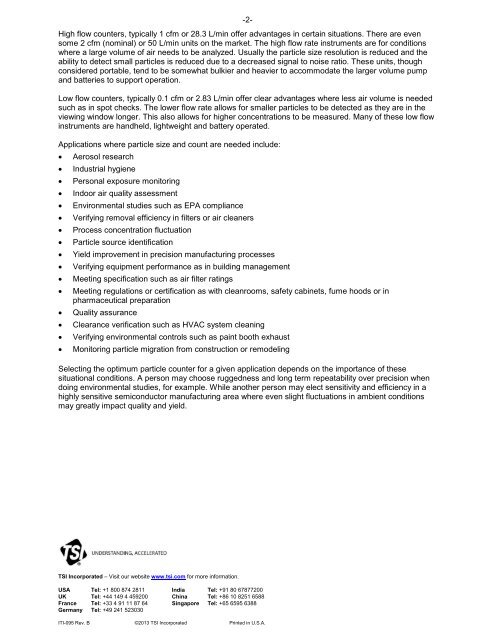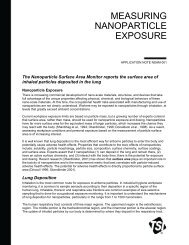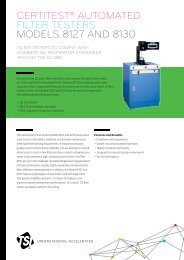Application Note ITI-095 Choosing an Optical Particle Counter - TSI
Application Note ITI-095 Choosing an Optical Particle Counter - TSI
Application Note ITI-095 Choosing an Optical Particle Counter - TSI
You also want an ePaper? Increase the reach of your titles
YUMPU automatically turns print PDFs into web optimized ePapers that Google loves.
<strong>TSI</strong> Incorporated – Visit our website www.tsi.com for more information.<br />
USA Tel: +1 800 874 2811<br />
UK Tel: +44 149 4 459200<br />
Fr<strong>an</strong>ce Tel: +33 4 91 11 87 64<br />
Germ<strong>an</strong>y Tel: +49 241 523030<br />
-2-<br />
High flow counters, typically 1 cfm or 28.3 L/min offer adv<strong>an</strong>tages in certain situations. There are even<br />
some 2 cfm (nominal) or 50 L/min units on the market. The high flow rate instruments are for conditions<br />
where a large volume of air needs to be <strong>an</strong>alyzed. Usually the particle size resolution is reduced <strong>an</strong>d the<br />
ability to detect small particles is reduced due to a decreased signal to noise ratio. These units, though<br />
considered portable, tend to be somewhat bulkier <strong>an</strong>d heavier to accommodate the larger volume pump<br />
<strong>an</strong>d batteries to support operation.<br />
Low flow counters, typically 0.1 cfm or 2.83 L/min offer clear adv<strong>an</strong>tages where less air volume is needed<br />
such as in spot checks. The lower flow rate allows for smaller particles to be detected as they are in the<br />
viewing window longer. This also allows for higher concentrations to be measured. M<strong>an</strong>y of these low flow<br />
instruments are h<strong>an</strong>dheld, lightweight <strong>an</strong>d battery operated.<br />
<strong>Application</strong>s where particle size <strong>an</strong>d count are needed include:<br />
Aerosol research<br />
Industrial hygiene<br />
Personal exposure monitoring<br />
Indoor air quality assessment<br />
Environmental studies such as EPA compli<strong>an</strong>ce<br />
Verifying removal efficiency in filters or air cle<strong>an</strong>ers<br />
Process concentration fluctuation<br />
<strong>Particle</strong> source identification<br />
Yield improvement in precision m<strong>an</strong>ufacturing processes<br />
Verifying equipment perform<strong>an</strong>ce as in building m<strong>an</strong>agement<br />
Meeting specification such as air filter ratings<br />
Meeting regulations or certification as with cle<strong>an</strong>rooms, safety cabinets, fume hoods or in<br />
pharmaceutical preparation<br />
Quality assur<strong>an</strong>ce<br />
Clear<strong>an</strong>ce verification such as HVAC system cle<strong>an</strong>ing<br />
Verifying environmental controls such as paint booth exhaust<br />
Monitoring particle migration from construction or remodeling<br />
Selecting the optimum particle counter for a given application depends on the import<strong>an</strong>ce of these<br />
situational conditions. A person may choose ruggedness <strong>an</strong>d long term repeatability over precision when<br />
doing environmental studies, for example. While <strong>an</strong>other person may elect sensitivity <strong>an</strong>d efficiency in a<br />
highly sensitive semiconductor m<strong>an</strong>ufacturing area where even slight fluctuations in ambient conditions<br />
may greatly impact quality <strong>an</strong>d yield.<br />
India Tel: +91 80 67877200<br />
China Tel: +86 10 8251 6588<br />
Singapore Tel: +65 6595 6388<br />
<strong>ITI</strong>-<strong>095</strong> Rev. B ©2013 <strong>TSI</strong> Incorporated Printed in U.S.A.




